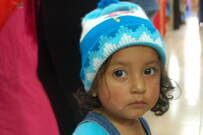
How to Make Pastry with Alcohol in Crete ©
Yes, we did use alcohol while making small delicious cheese pies, kalitsounia, in a traditional hillside village of western Crete. Raki, a potent local brew made from grape skins and stems left from the distillation of wine, adds flavour to the pastry. Not only that but lacing our cooking course with liberal glasses of village wine produced happy cookers
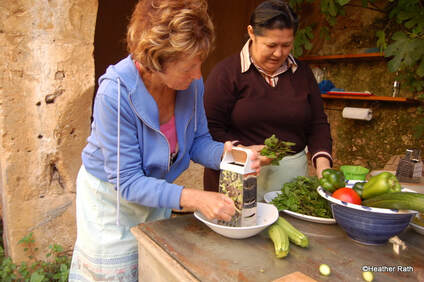 The author grates zucchini under the watchful eye of Koula Barydakis, the chef-instructor who believes that the food of Crete, Greece, is the healthiest in the world.
The author grates zucchini under the watchful eye of Koula Barydakis, the chef-instructor who believes that the food of Crete, Greece, is the healthiest in the world.
Koula Barydakis, our ebullient chef instructor, began lessons by pouring a shot of raki for herself and her students as we toasted the traditional Cretan diet, one of the healthiest in the world.
“We Cretans eat abundantly but simply, consuming much olive oil, olives, seasonal fruits and vegetables including wild mountain greens (horta), yogurt, cheese, lentils and beans. We eat meat once a week and on special occasions. We always drink a lot of mountain tea (malotera, good for the stomach) while eating bread and olives.” Recipes are flavoured with native herbs like oregano, thyme and sage. Red wine commonly accompanies lunch and dinner.
“We Cretans eat abundantly but simply, consuming much olive oil, olives, seasonal fruits and vegetables including wild mountain greens (horta), yogurt, cheese, lentils and beans. We eat meat once a week and on special occasions. We always drink a lot of mountain tea (malotera, good for the stomach) while eating bread and olives.” Recipes are flavoured with native herbs like oregano, thyme and sage. Red wine commonly accompanies lunch and dinner.
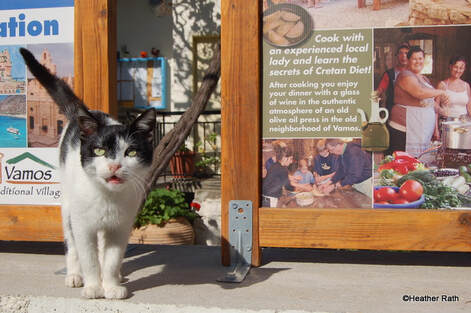 Even cats have something to contribute to food sustainability in Crete, Greece
Even cats have something to contribute to food sustainability in Crete, Greece
When it comes to food, Koula proudly proclaims Crete has practised sustainable living without using the name. Raki--- that most famous of Cretan alcohol---- is derived from the residue of grape pressing. Most fruits and vegetables consumed are seasonal, not imported from faraway places. Crops are grown naturally without fertilizers and pesticides “like our forefathers”. In her village, goats make short work of any scraps of food. Chickens are really free range; fresh eggs contain bright orange yolks. Even the scavenger street cats of Crete are part of the solution!
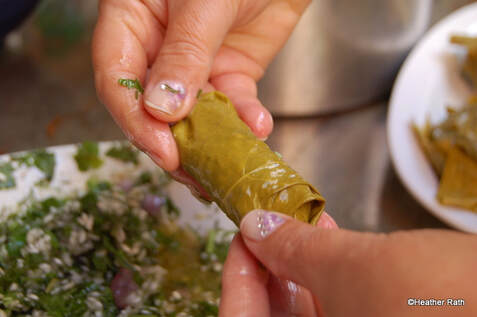 Delicious handmade dolmades (grape leaves stuffed with rice) are typical of the cuisine on Crete, Greece.
Delicious handmade dolmades (grape leaves stuffed with rice) are typical of the cuisine on Crete, Greece.
Koula recalls how her parents sent her to hairdressing school to learn how to earn a living unaware she also attended cooking school where she refined the culinary skills learned from her mother and grandmother. At 16, she left Crete to travel abroad but spent most of her new life as a chef in Toronto, Canada’s Greektown before her “blessed island” lured her home again.
She conducts her cooking classes under a patch of cobalt blue sky in an old olive oil press building renovated 10 years ago in Vamos, a traditional village. In case of rare inclement weather, she moves to a house.
She conducts her cooking classes under a patch of cobalt blue sky in an old olive oil press building renovated 10 years ago in Vamos, a traditional village. In case of rare inclement weather, she moves to a house.
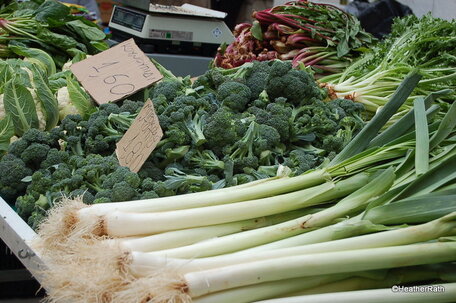 The market of fresh greens in Crete, Greece, help to make the local cuisine so rich in variety of and nutrition.
The market of fresh greens in Crete, Greece, help to make the local cuisine so rich in variety of and nutrition.
During our session, we chopped, grated, mixed, pressed, formed---and dined on---rooster with Cretan pasta, kalitsounia pies, grape leaves with rice (dolmades), zucchini fritters, Greek salad, and garlic beets with yogurt salad washed down with liberal amounts of village wine.
Cooking Cretan style is not the only lesson Koula taught us. She is an exuberant ambassador for her island: “Crete is a beautiful island filled with bountiful food. The wild, natural beauty of the mountains and the ocean make you think that when God created Crete, He created all the beauty the human mind can imagine. The land is so rich with olive, lemon, and orange trees and gardens the smell alone can make you drunk. The wide variety of herbs and flowers from ancient times found on Crete are still used to cure pains and diseases. Writers, explorers, scientists, and tourists all come to Crete to see it, study it, eat the tasty foods, drink the raki, and get high on the immortal wines of Crete. The people of Crete live simply and always win your heart.”
Cooking Cretan style is not the only lesson Koula taught us. She is an exuberant ambassador for her island: “Crete is a beautiful island filled with bountiful food. The wild, natural beauty of the mountains and the ocean make you think that when God created Crete, He created all the beauty the human mind can imagine. The land is so rich with olive, lemon, and orange trees and gardens the smell alone can make you drunk. The wide variety of herbs and flowers from ancient times found on Crete are still used to cure pains and diseases. Writers, explorers, scientists, and tourists all come to Crete to see it, study it, eat the tasty foods, drink the raki, and get high on the immortal wines of Crete. The people of Crete live simply and always win your heart.”
Koula lives her philosophy. Following my lesson, our weekends in Crete soon featured Saturdays With Koula. Each Saturday we met for coffee in a different place of Chania after which she took us on a leisurely walking tour to show us excellent local restaurants, markets, and point out where to purchase good local wines. She led us to special churches, monasteries and gave us a thumbnail sketch of Cretan feast holidays. Our education included the island’s Second World War history and how it affected her village and family.
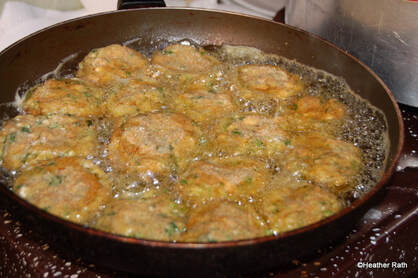 Zucchini fritters frying in olive oil in Crete, Greece.
Zucchini fritters frying in olive oil in Crete, Greece.
Dough for (cheese/spinach) pies
4 cups all-purpose flour, ¼ cup raki, a pinch of salt, warm water (as much as needed), ½ cup olive oil.
Mix the ingredients and knead them well. The pastry must be a little soft. Leave the pastry to ‘rest’ for half an hour, covered with a towel.
Hint: Koula says instead of raki you can use white wine or lemon juice!
Cheese stuffing: Mix equal amounts of ricotta and feta cheese, 2 eggs, chopped sprigs of fresh mint, and salt.
Place the mixture on the pastry as below:
Roll the dough until it is not more than 1-2 mm thick, cut it into round shapes of about 8 cm, put in a little stuffing and fold in a half moon shape. Seal edges with a fork.
Fry in hot olive oil. When they are browned on both sides, remove and serve.
Kali oreksi, enjoy your meal!
Published: The Travel Word, December 14, 2011
4 cups all-purpose flour, ¼ cup raki, a pinch of salt, warm water (as much as needed), ½ cup olive oil.
Mix the ingredients and knead them well. The pastry must be a little soft. Leave the pastry to ‘rest’ for half an hour, covered with a towel.
Hint: Koula says instead of raki you can use white wine or lemon juice!
Cheese stuffing: Mix equal amounts of ricotta and feta cheese, 2 eggs, chopped sprigs of fresh mint, and salt.
Place the mixture on the pastry as below:
Roll the dough until it is not more than 1-2 mm thick, cut it into round shapes of about 8 cm, put in a little stuffing and fold in a half moon shape. Seal edges with a fork.
Fry in hot olive oil. When they are browned on both sides, remove and serve.
Kali oreksi, enjoy your meal!
Published: The Travel Word, December 14, 2011